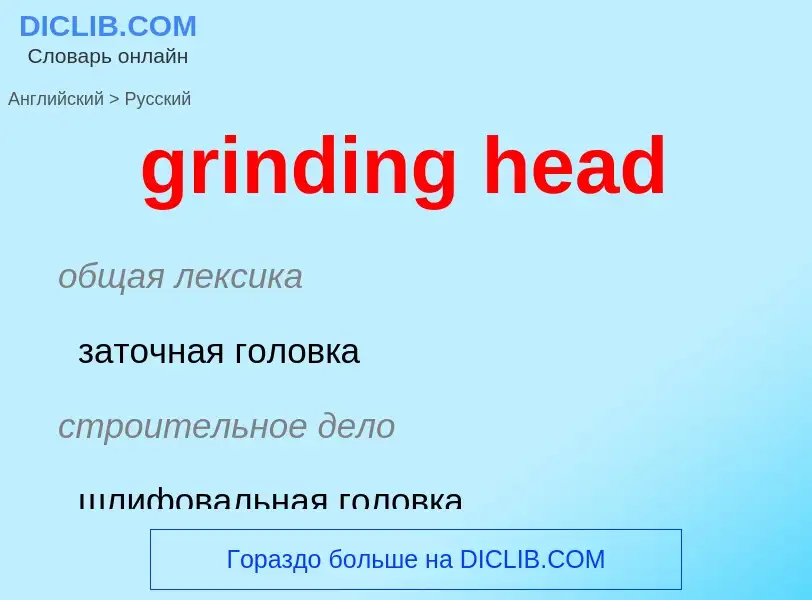Перевод и анализ слов искусственным интеллектом ChatGPT
На этой странице Вы можете получить подробный анализ слова или словосочетания, произведенный с помощью лучшей на сегодняшний день технологии искусственного интеллекта:
- как употребляется слово
- частота употребления
- используется оно чаще в устной или письменной речи
- варианты перевода слова
- примеры употребления (несколько фраз с переводом)
- этимология
grinding head - перевод на русский
общая лексика
заточная головка
строительное дело
шлифовальная головка
шлифовальная бабка, бабка шлифовального станка
общая лексика
круглое шлифование
медицина
бруксизм (скрежетание зубами, особенно во время сна)
одонтопризис
общая лексика
жевательные зубы (премоляры и моляры)
общая лексика
стержневая барабанная мельница
общая лексика
бегуны мелкого помола
медицина
окружность головы
[hed'redʒistə]
музыка
головной регистр
['hedtəun]
синоним
Определение
Википедия
Bruxism is excessive teeth grinding or jaw clenching. It is an oral parafunctional activity; i.e., it is unrelated to normal function such as eating or talking. Bruxism is a common behavior; reports of prevalence range from 8% to 31% in the general population. Several symptoms are commonly associated with bruxism, including aching jaw muscles, headaches, hypersensitive teeth, tooth wear, and damage to dental restorations (e.g. crowns and fillings). Symptoms may be minimal, without patient awareness of the condition. If nothing is done, after a while many teeth start wearing down until the whole tooth is gone.
There are two main types of bruxism: one occurs during sleep (nocturnal bruxism) and one during wakefulness (awake bruxism). Dental damage may be similar in both types, but the symptoms of sleep bruxism tend to be worse on waking and improve during the course of the day, and the symptoms of awake bruxism may not be present at all on waking, and then worsen over the day.
The causes of bruxism are not completely understood, but probably involve multiple factors. Awake bruxism is more common in women, whereas men and women are affected in equal proportions by sleep bruxism. Awake bruxism is thought to have different causes from sleep bruxism. Several treatments are in use, although there is little evidence of robust efficacy for any particular treatment.

.png?width=200)



![sparks]] sparks]]](https://commons.wikimedia.org/wiki/Special:FilePath/2 الحداد.jpg?width=200)

![[[Machinist]]s grinding workpieces on a [[bench grinder]]. [[Machinist]]s grinding workpieces on a [[bench grinder]].](https://commons.wikimedia.org/wiki/Special:FilePath/Machinists grinding workpieces on a bench grinder..jpg?width=200)


![A [[windmill]] in [[Kuremaa]], [[Jõgeva County]], [[Estonia]] A [[windmill]] in [[Kuremaa]], [[Jõgeva County]], [[Estonia]]](https://commons.wikimedia.org/wiki/Special:FilePath/Kuremaa mõisa tuuleveski.jpg?width=200)
![A [[watermill]] in [[Kuusamo]], [[North Ostrobothnia]], [[Finland]] A [[watermill]] in [[Kuusamo]], [[North Ostrobothnia]], [[Finland]]](https://commons.wikimedia.org/wiki/Special:FilePath/Mill in the woods (31546576571).jpg?width=200)




![A man wearing a [[straw hat]] A man wearing a [[straw hat]]](https://commons.wikimedia.org/wiki/Special:FilePath/0004 Madagascar (5558700320).jpg?width=200)
![physical characteristics]] of the head - redrawn.</big>}} physical characteristics]] of the head - redrawn.</big>}}](https://commons.wikimedia.org/wiki/Special:FilePath/AvgHeadSizes.png?width=200)
![[[Dayak people]] were feared for their headhunting practices [[Dayak people]] were feared for their headhunting practices](https://commons.wikimedia.org/wiki/Special:FilePath/COLLECTIE TROPENMUSEUM Een Ibu Dajak krijger uit Long Nawan Z. en O. afdeling Borneo. TMnr 60034031.jpg?width=200)
